This cache was placed as part of the brand new Space Coast Geo Adventures. Space Coast Tourism has teamed up with local geocachers to place these caches in 15 different locations across the county. Click Space Coast Geo Adventures for more information on this Adventure.
Proud Members Of

Let’s get started! At the parking cords you will see a statue of Juan Ponce DeLeon. Take a closer look. Where was this statue made? A: Madrid, Spain, B: San Juan, Puerto Rico, C: Rockledge, FL
Now head head over to Coconut Point Sanctuary just cross A1A and begin your adventure through these rare and intriguing dunes. Turn north to access the trail-head. This enchanting little area helps preserve some of our ancient sand dunes. A narrow foot trail takes you through coastal scrub down into a forest of live oak and mangrove along the Indian River Lagoon. As you walk along this ¾ mile trail, you’ll be challenged to use your power of observation rather than a GPS to find all the answers to my questions. If you can locate each tree described in my narrative, you will be rewarded with the coordinates to the final.
The starting coordinates for this cache will take you to the trail-head where you can sign the guest register. This small act of support helps the sanctuary record the number of visitors and gain funding. Head west along the trail until you come to a sign about Scrub Jays. Where do these bold friendly birds like to hide their acorns? A: caches, B: stashes, C: burrows.
You’ve completed the warm-up. Now it’s time to begin looking for some of the more common trees found in this coastal environment. Follow the trail as it snakes through a thicket of saw palmetto. Keep your eyes open for the rabbits that play here. Love vine drapes itself around clumps of saw palmetto and scrub oak like orange spaghetti while colorful wildflowers jealousy vie for your attention. Are you beginning to feel the hot Florida sun beating down on your back?
The trail brings you into a sparse oak canopy-the first place you will be walking underneath trees and maybe some shade. Watch out for a low branch that arches over the trail. It could give a tall person a real headache. When you discover this tree, stop and stand with your back to its trunk. The branch you are standing under reaches north towards a tall Coral Bean tree approximately 5 paces off the trail. There is a natural break in the thick vegetation near this spot. Follow this opening and look for a tree with a distinctive arrowhead shaped leaf, smooth light colored bark and bright red tubular flowers. The flowers produce pods with bright red poisonous seeds which have been used as a rat poison. What other feature do you find on this tree? A: a thick solitary trunk, B: tiny sharp curved thorns, C: a minty smell
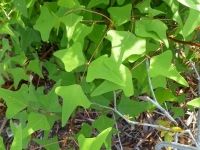
The trail leads on through more saw palmettos. Stop when you reach the place in the trail where a series of three gator backs cross your path and might even cause you to trip. You are about to enter a forest of dancing oaks. Before you step over the last gator back, look up at the low branch hanging overhead. Your standing under a Sand Live Oak. These Oaks have “twins” or paired acorns on short stalks. The leaves are long ovals deeply rounded on the sides so that they look like little boats when turned upside down. The bark is a thick dark grayish brown and deeply furrowed. What do you see at the base of this particular Sand Live Oak? A: fire damage, B: blue paint, C: several large coquina stones.
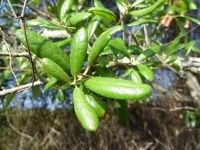
Continue down the trail until you leave the last of the Sand Live Oaks behind and the sand underfoot changes to an orange-like color. This type of sand is made up of grains coated with iron oxide. You'll pass under the power lines and then the trail takes you through the Sabal Palm Gates our Florida state tree, also known as Cabbage Palm (swamp cabbage for you southern folk). The terminal bud is edible (hearts of palm for you Yankees). This tough little tree tolerates salt, cold, drought, floods, fire and the occasional hurricane. Some of these palms have their boots while others have shed them. Stand at the gates and look at the Sabal Palm on either side of you. What do you observe? A: both Sabal Palms are wearing their boots, B: one Sabal Palm has boots and the other does not, C: both Sabal Palms have shed their boots.
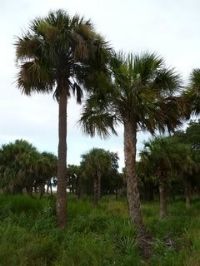
Once you’ve counted the the number of Sabal Palms with boots, head on down the trail and across “Bobcat” road. A friend and I were fortunate to spot two bobcats on the west end of this road. You might be able to find some of their tracks in the sand.
The landscape changes dramatically as the trail takes you down into a coastal hammock with huge Live Oaks, giant leather ferns and white mangroves. You will pass a sign warning about gators and then cross a boardwalk followed by a narrow puncheon that leads up to a second boardwalk. When you come to the end of a second puncheon you should see a sign describing the Maritime Hammock. You’re standing under the dense canopy of several huge live oaks. Duck under the low archway directly in front of the sign and walk about 3 paces off the trail to find a tall slender tree with light bark. Strangler fig is the common name for a number of plant species that share a similar “strangling” growth habit. The seeds can be dispersed through bird droppings and often begin life high up in trees as epiphytes.
Epiphytes draw their moisture and nutrients from the air, rain, and sometimes from debris accumulating around it instead of the plant it is fastened to. Strangler fig seedlings grow roots downward into the soil, branch out into multiple offshoots and eventually engulf the host tree. The shiny leaves are thick and leathery. Broken twigs exude a milky sap that can irritate the skin. What is this strangler fig strangling? A: a gator back, B: a sabal palm, C: an old telephone pole.
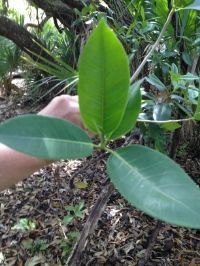
Continue along the trail. Somewhere back in here is a Rogue geocache with an amusing historical glimpse of some of Brevard’s first geocachers. You will pass a third boardwalk and another long curvy puncheon. The trail comes to a fork with a second gator warning sign. Turn to the right to walk the short spur trail out to the Indian River Lagoon overlook. At the base of one corner of the overlook is a large seagrape. The seagrape has large round leathery leaves with heart-shaped bases. In the summer it bears clusters of grape-like fruit that ripen to a reddish color. The fruit is tasty but has a large pit. It can be eaten right off the plant or made into a delicious jam. Check out the view of the Indian River Lagoon from the overlook. I often see dolphin chasing fish nearby in the aquatic grassbeds. Look around until you find a Buncha' Sallies. How many Sallies did you find? That’s your answer for D.
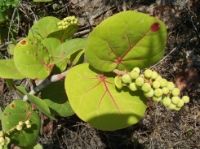
Return to the main trail and continue south. You’ll follow one more curvy puncheon that leads to a straightaway. Before the trail curves again you will pass between two large Hercules trees. The Hercules Club has light grey, smooth, thin bark, with large thick spines partially enclosed by corky warts. (Large warts !) It’s also called the toothache tree because chewing on the bark helps numb the pain of a toothache. The trunk of the tree is splattered with lichens of what color? A: bright orange, B: yellow, C: pink

The trail takes you past a bench, into a tree tunnel and on to a small sunny clearing with a double arrow trail marker on your left. From the middle of the clearing take about 3 paces to the right (south-west) and look up. Your standing under a scrub hickory tree. Scrub hickory has light grey bark with patches of lichens. They have long light green leaves with delicate yellow veins often seen in distinct patterns of three, five or seven leaflets. The underside of the leaf can have a rusty color. The seed of the scrub hickory is edible and taste sweet. Examine the backside of the trunk. What do you see just above eye level on this scrub hickory? A: a broken splintered branch, B: several old rusty square nails, C: graffiti
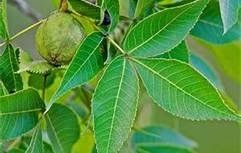
Last Question. What is Dendrology? A: the study of trees, B: the study of coastal sand dunes, C: any puzzle that involves logical deduction
Time to tally up those answers. E will be the number of Sallies minus C. Enter some cords into your GPS and go find the final. No need to bushwhack to it; look for a natural break in the vegetation.
Good Luck!